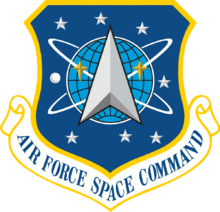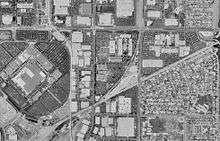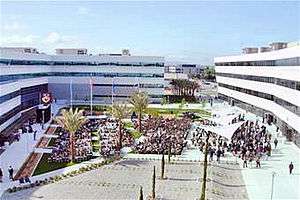Los Angeles Air Force Base
Los Angeles Air Force Base | |
|---|---|
| Part of Air Force Space Command (AFSPC) | |
| El Segundo, California, USA | |
|
The dedication ceremony of the Schriever Space Complex at Los Angeles AFB on 24 April 2006. | |
| Coordinates | 33°55′08.79″N 118°22′50.23″W / 33.9191083°N 118.3806194°WCoordinates: 33°55′08.79″N 118°22′50.23″W / 33.9191083°N 118.3806194°W |
| Type | Air Force Base |
| Site information | |
| Owner |
|
| Controlled by | Air Force Space Command |
| Site history | |
| Built | 1962 |
| In use | 1962-present |
| Garrison information | |
| Garrison |
|
| Occupants |
|
Los Angeles Air Force Base (LAAFB) is a non-flying United States Air Force Base located in El Segundo, California. Los Angeles Air Force Base houses and supports the headquarters of the Air Force Space Command's Space and Missile Systems Center (SMC). The center manages research, development and acquisition of military space systems. The 61st Air Base Wing provides support functions for the base.
Overview
Los Angeles Air Force Base is headquarters to the Space and Missile Systems Center (SMC), part of Air Force Space Command. SMC is responsible for research, development, acquisition, on-orbit testing and sustainment of military space and missile systems. In addition to managing Air Force space and missile systems, SMC participated in space programs conducted by other U.S. military services, government agencies and North Atlantic Treaty Organization (NATO) allies. SMC turns these systems over to the appropriate operating command. SMC also serves as the integrating center for the Strategic Defense initiative within Air Force Material Command. It monitors progress in more than 70 Space Defense Initiative efforts throughout AFMC. SMC itself has direct management responsibility for more than half of those efforts.[1]
Los Angeles AFB is the only active duty installation in Los Angeles County. In addition to personnel assigned to the base, it serves all active-duty military personnel in the Greater Los Angeles area. The base, located in El Segundo, houses the main installation. Fort MacArthur, which is located 20 miles south, is a separate part of the base.
Units
- The 61st Air Base Group provides medical, civil engineering, communications, chaplain, security, logistics, personnel, readiness, and quality-of-life services to the Space and Missile Systems Center and other Department of Defense units in the Los Angeles basin. It consists of five squadrons and six staff agencies, totaling more than 790 personnel with $608 million in plant assets and an annual budget of $60 million.[1]
- SMC is the birthplace of military space and center of military space acquisition excellence. Their mission is to deliver resilient and affordable space capabilities for the nation.[1]
- Formerly the Global Positioning Systems Wing, the Global Positioning Systems Directorate is a joint-service, multinational, civil/military systems directorate with more than 700 DoD/contractor personnel responsible for development, launch and sustainment of the Global Positioning System, the world's premier navigation and timing standard. The directorate is responsible for the development and procurement of over 250,000 receiver systems and the United States' nuclear detonation detection system. Annual funding is $1billion and total program value is $32 billion.[1]
- Formerly the Space Superiority Systems Wing, the Space Superiority Systems Directorate is responsible for equiping the joint warfighter with unrivaled offensive and defensive counterspace, space situation awareness and special access capabilities required to gain, maintain and exploit space superiority. The directorate executes cradle-to-grave responsibility for weapon systems development, fielding and sustainment.[1]
- Launch Enterprise Directorate
- The Launch Enterprise Directorate provides DoD and the National Reconnaissance Office with assured access to space through launch systems modernization, sustainment and development of worldwide range capability for all national security missions. The directorate conducts satellite mission integration and provides reliable, integrated tools to test and support the nation's space launch, ballistic missile and aeronautical testing.[1]
- Formerly the Space-Based Infrared Systems Wing, the Infrared Space Systems Directorate develops, deploys, and sustains $27 billion in surveillance satellites and ground stations to detect, track, and report global and theater ballistic missile attacks against the United States, its allies and combat forces. The satellites and ground stations provides global surveillance, tracking, and targeting information to warfighters and intelligence units.[1]
- Defense Weather Systems Directorate
- The directorate equips worldwide strategic and tactical forces with weather and space environmental data for planning and executing aerospace, ground and naval operations. The $3.5-billion program develops, tests, acquires, and sustains satellites, sensors and ground systems to meet warfighter requirements. It provides launch support, early orbit operations and spacecraft anomaly resolution of DoD's sole operational weather satellite system.[1]
- MILSATCOM Systems Directorate
- Formerly the Military Satellite Communications Systems Wing, the MILSATCOM Systems Directorate plans for, acquires and sustains space-enabled global communications in support of the president, secretary of Defense and combat forces. MILSATCOM systems consists of satellites, terminals, and control stations, worth more than $42 billion providing communication for approximately 16,000 aircraft, ships, mobile and fixed sites. As a jointly-manned directorate, it interfaces with major commands from each of the Armed Services, HQ Air Force and various DoD agencies.[1]
- Advanced Systems and Development Directorate
- The premier organization for advanced systems and development planning to evolve and implement new affordable and resilient architectures for future Space capabilities through analytical rigor, collaborative innovation, requirements analysis, concept development, and demonstrations. Serves as primary provider of launch, spaceflight, hosted payloads and on-orbit operations for the entire DoD space research and development community. Responsible for acquiring, integrating, launching, and operating R&D spacecraft, prototype operational systems, boosters, and ballistic missiles supporting national security objectives/missile defense programs. Co-located at LAAFB and Kirtland AFB, New Mexico.
- Space Logistics Directorate
- Located at Peterson AFB, Colorado, the Space Logistics Directorate has 550 people and a $500 million annual budget. It sustains and modifies worldwide USAF/DoD space weapon systems to include terrestrial and space weather, global positioning systems, launch range control, satellite command and control, secure communications, and missiles early warning. The directorate is the focal point for logistics, maintenance, supply, sustaining engineering and the Space Logistics Readiness Center.[1]
- Operationally Responsive Space Office
- The mission of the ORS Office is to plan and prepare for the rapid development of highly responsive space capabilities that enable delivery of timely warfighting effects and, when directed, develop and support deployment and operations of these capabilities to enhance and assure support to Joint Force Commanders' and other users' needs for on-demand space support, augmentation, and reconstitution.[1]
- Range and Network Division
- The Range and Network Division is responsible for modernizing and sustaining the world-wide Air Force Satellite Control Network as well as the nation's Launch and Test Range Systems located at Vandenberg AFB, California, and Cape Canaveral AFS, Florida.[1]
History

Los Angeles Air Force Base traces its history back to the Air Research and Development Command's Western Development Division, which was activated on 1 July 1954 in Inglewood, not far from the current base.
In 1961, the Air Force developed a plan to consolidate its Space Systems Division and the Research and Development (R&D) Center of The Aerospace Corporation, which had been created in 1960 to support Air Force space programs. The plan involved acquisition of two pieces of real estate adjoining the R&D Center. An aircraft plant owned by the Navy at the northwest corner of Aviation and El Segundo Boulevards, was transferred to the Air Force in October 1962. Another site at the southwest corner of the same intersection, was owned by a mining company. The Aerospace Corporation acquired that site in November 1962 and built its new headquarters there between February 1963 and April 1964. By April 10, 1964, the Air Force property at the intersection of Aviation and El Segundo Boulevards was designated as Los Angeles Air Force Station, which was re-designated Los Angeles Air Force Base in September 1987.
In 2006, Area A of LAAFB was permanently closed after a deal with a local builder to exchange the land in Area A for the creation of the Schriever Space Complex on Area B and other new facilities. In February 2007, a new base exchange opened up on Area B.
The portion of Fort MacArthur remaining in military use is a sub-base of Los Angeles Air Force Base serving as a housing and administrative annex. Fort MacArthur is in the San Pedro district of Los Angeles, approximately twenty miles south-east of Los Angeles Air Force Base.
References
![]() This article incorporates public domain material from the Air Force Historical Research Agency website http://www.afhra.af.mil/.
This article incorporates public domain material from the Air Force Historical Research Agency website http://www.afhra.af.mil/.
External links
- Official website
- The Douglas Aircraft Plant That Became Los Angeles Air Force Base
- Historical Overview of the Space and Missile Systems Center, 1954-2003

